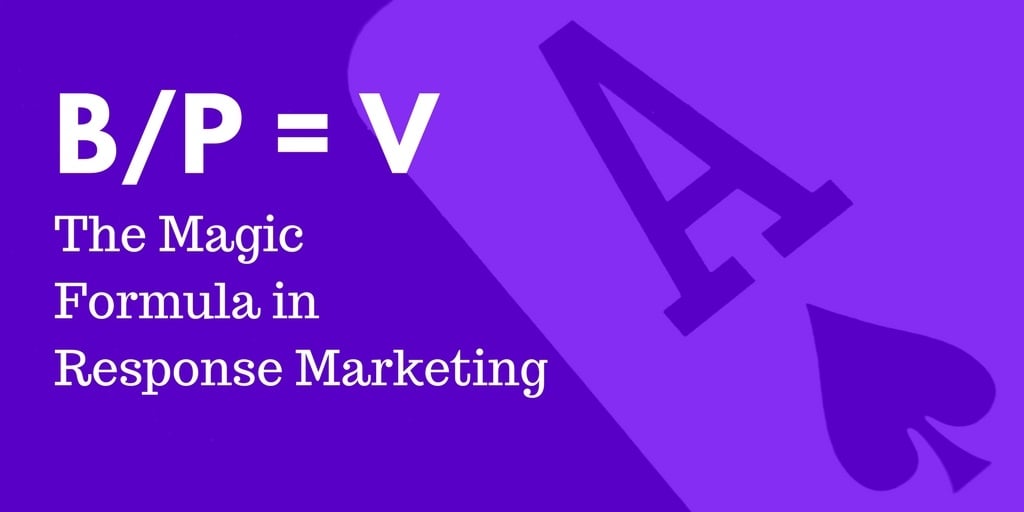

J&C Blog
Find all the latest marketing trends on the J&C Blog.

Find all the latest marketing trends on the J&C Blog.
Here’s something all response marketers have in common:
Regardless of whether you’re in finance, insurance, automotive, B2B, etc., we all need to generate sales.
If we don’t, well, I guess there’s always Uber.
But the age-old question is “how?” How do you get people to purchase your product or service rather than your competitor’s? Or, to dive even deeper into the human psyche, why do people buy in the first place? What motivates them? Why do they choose Product A over Product B?
Now there’s the million-dollar question.
Unlike direct response marketers, customers are all over the board. They have different wants, different needs, different price points; they’re in different age groups; and on and on.
If only there were ONE magic formula that we could apply to all consumers to understand what they value.
Wait... There is. And it goes like this:
The “B” = Benefit
The “P” = Price
The “V” = Value
At some point, every consumer will consider how much benefit your product yields and divide those benefits by the price you’re charging. This will allow them to ascribe an overall “value” to your product.
And it all happens in a split second. It may not be a conscious calculation on the consumer’s part, but rather something Daniel Kahneman calls “System 1” thinking of the brain. It’s where things like “intuition” and “gut” decisions are made.
Malcolm Gladwell describes this phenomenon as how we “think without thinking.” He says it’s about the choices we make in the blink of an eye. Sometimes these decisions can be quite complex — like BP=V. Yet, they happen quickly.
In response marketing, we need to know and understand how customers are making their “go/no go” decisions.
So let’s break down this magic formula: Benefit ÷ Price = Value. We’ll look at this through the consumer’s eyes.
This is how your product personally affects the consumer. It “lives” independently of and apart from your product or service. This is how your product or service “improves” your customer’s life.
To be clear, benefits are not selling points. A 20-megapixel camera (feature) gives the customer more realistic color and clarity to enjoy. This enjoyment personally affects the customer’s experience.
Not just money. This could be the consumer’s time, extra effort, their confidence or even their trust. It’s anything of value the customer has to give in exchange for the benefit. And it’s important to do anything in our power to lower the price.
Per the magic formula, divide the benefit by price to get the value. Pretty straightforward. But under no circumstances should “value” be confused with “cheap.”
All right, so we have that under our belts. Now how do we, as response marketers, convince our customers that they are getting a great value? This part is a little tricky. So here are three rules to help you bring out the “value” in your copy:

You should know every possible benefit and every major selling point. Once you do, make an outline of those benefits and selling points.

Yes, demographics, lifestyles, personas, purchasing behavior, etc. Get inside your customers’ heads. What excites them? What are they passionate about? What makes them perk up and take notice? IMPORTANT: This is NOT about you. You are not the target audience and your preferences are not necessarily their preferences.
Once you have a “visual” of your customers, you’ll want to speak to them like they were sitting across the kitchen table from you. When you start writing, write like you talk. Start by translating your “spoken” sales pitch into written copy. Revise and polish from there.
This is key. And you must make that promise so that it speaks to customers’ most urgent need. Use terms they knows. Let them know that you understand them. And make clarity your top priority.
Also, remember to be thorough. This is especially important for response marketers. As the only salesperson in the dialogue, it’s up to you to explain the product and its value. If you leave something out, there's no one else the prospect can ask. You can do an amazing job organizing, researching, outlining and writing ... only to lose the sale because you forgot to include the size, colors or some other obvious point.
If you can work these rules into your direct response marketing copy, you’ll stand a much better chance of getting customers to understand the real value in your product or service.
For more insights, sign up to receive the J&C marketing newsletter.
Topics: Direct Marketing
303 E Wacker Drive, Suite 2030
Chicago, IL 60601
Phone: 312-894-3000
Fax: 312-894-3005